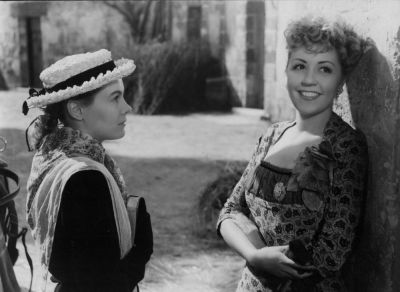
PATTES BLANCHES
(Francia/1948) R.: Jean Grémillon. D.: 103'. V. francese
Dopo diciotto mesi di preparazione, Grémillon è costretto ad abbandonare Le Printemps de la liberté, un progetto di film storico sul 1848, e accetta di sostituire il commediografo Jean Anouilh ai comandi di Pattes blanches, film che quest'ultimo aveva scritto e che aveva dovuto rinunciare a dirigere per problemi di salute. Il regista sposta l'ambientazione dal XIX secolo al presente ed effettua le riprese degli esterni nella 'sua' Bretagna, dove la storia si orchestra intorno a cinque personaggi: Odette (Suzy Delair), femme fatale che ha seguito l'amante Jock (Fernand Ledoux), albergatore, in un villaggio della costa bretone, dove sorge un castello abitato dal solitario Julien De Kériadec, soprannominato 'Pattes blanches' (ghette bianche) dai paesani. L'uomo, che non tarda a innamorarsi follemente di Odette, è venerato dalla giovane domestica gobba Mimi ed è odiato dal fratellastro Maurice (il giovane e febbrile Michel Bouquet). Kériadec decide di vendere il castello avito per conquistare Odette ma la donna preferisce sposare Jock, che le garantisce la sicurezza economica. Maurice induce Odette a umiliare Kériadec e questi, in un attacco di collera, la insegue tra le brume per poi strangolarla e gettarla sulla scogliera. L'universo nero e disperato di Anouilh ispira la fantasia di Grémillon, che modella con finezza i caratteri di ogni personaggio, arricchendoli di contraddizioni e sfumature. In particolare la piccola Mimi, dai lineamenti angelici e dal fisico deforme, che cercherà di aiutare l'infelice castellano, e Odette, che è una variante più aggressiva e carnale di femme fatale, dopo la Madeleine di Gueule d'amour. Ritorna anche in Pattes blanches il tema della degradazione provocata dalla passione amorosa, che travolge il castellano. Il clima morboso e sensuale che si addensa intorno all'esuberanza e alla malizia di Odette è reso da Grémillon con un'atmosfera sempre più angosciosa e cupa. Alla dimensione barocca di questo mélo noir contribuisce soprattutto la scenografia di Léon Barsacq (già con Grémillon per Lumière d'été), in particolare il castello dalle stanze immense ma desolate e vuote, che nel finale (quando Kériadec progetta di incendiare il maniero e di suicidarsi) vengono riempite da fasci di paglia secca. Di grande bellezza plastica la sequenza dell'omicidio di Odette, in particolare l'inquadratura di Kériadec che trattiene in mano il velo della donna che ha fatto precipitare fra le rocce.
(Roberto Chiesi)
After 18 months of preparation, Grémillon was compelled to abandon Le Printemps de la liberté, a period film on 1848, and accepted to substitute the playwright Jean Anouilh at the head of Pattes blanches, a film that the latter had written but was forced to abandon for health reasons. The director moved the setting from the nineteenth century to the present and shoots the first outdoor scenes in 'his' Brittany, where the story centers around five characters: Odette, femme fatale that followed her lover Jock, a hotelier, in a village on the coast where there is a castle inhabited by the secluded Julien De Kériadec, nicknamed 'pattes blanches' (white spats) by the villagers. The man, who soon falls madly in love with Odette, is revered by the young hunchback servant Mimi and is hated by his step-brother Maurice (the young and feverish Michel Bouquet). Kériadec decides to sell the castle to win over Odette, but she chooses instead to marry Jock, thus guaranteeing her economic stability. Maurice persuades Odette to humiliate Kériadec, who, in a fit of rage, chases her through the mist and ends up strangling her and throwing her off a cliff. The dark and desperate universe of Anouilh inspires Grémillon's imagination, as he finely crafts the features of each character, enriching them with contradictions and subtleties. In particular little Mimi, with her angelic face and a deformed body, who tries to help the wretched lord of the manor, and Odette, a more aggressive and carnal version of a femme fatale when compared to Madeleine/Mireille Balin of Gueule d'amour. The theme of degradation as a consequence of lustful passion also makes a return in Pattes blanches. The sick and sensual atmosphere that gathers around the exuberance and malice of Odette is rendered by Grémillon with an increasingly distressing and dark mood. The art direction of Léon Barsacq (who had collaborated with Grémillon on Lumière d'été) contributes to the already baroque dimension of this noir mélo. The castle with enormous yet desolate and empty rooms, which in the final sequence (when Kériadec plots to set the manor on fire and commit suicide) are filled with dry hay, is a prime example. The sequence of Odette's murder is of particular visual beauty, especially the shot of Kériadec holding in his hand the veil of the woman he dropped among the rocks.
(Roberto Chiesi)

Tariffe:
Aria condizionata
Info: 051224605











